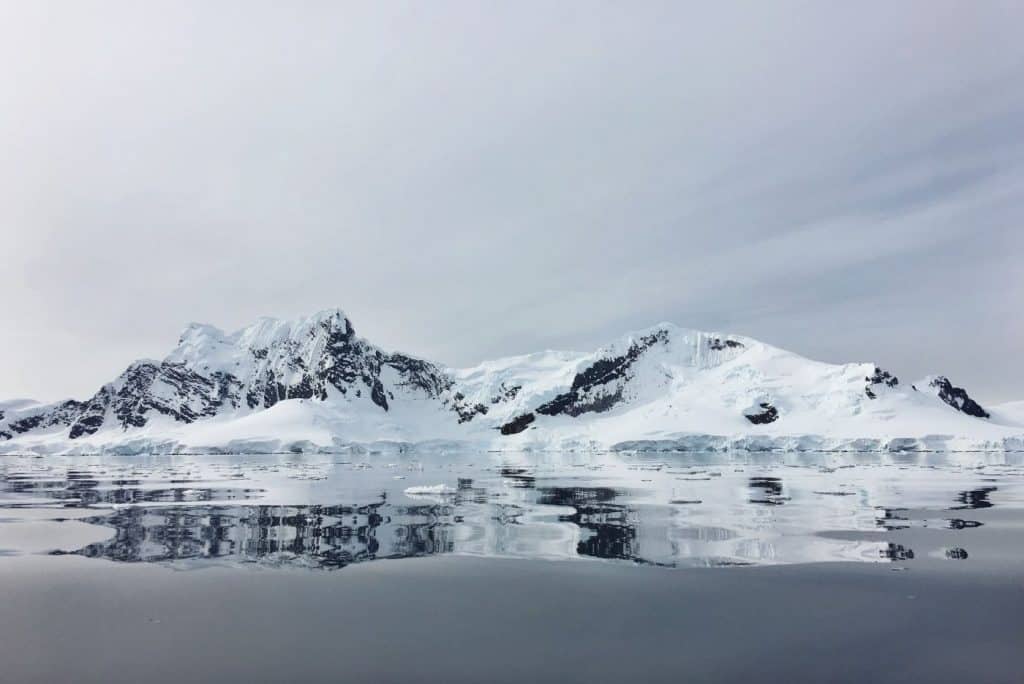- TRAVEL GUIDES
arrow_drop_down
- Canada
- United States
- Sunny Destinations
arrow_drop_down
- VIEW ALL
- BUCKET LIST
- ABOUT
- CONTACT
Travel Guide to Antarctica: Tips to Know Before Booking
- Antarctica
-
Apr 30
- Share post

Antarctica is the last frontier on Earth – the most remote and unexplored continent on the planet.
You’ll need to do your research to find one of the handful of tour operators that will take you on a journey through the Antarctic Circle.
Here’s a quick travel guide if you’re planning a trip to the icy continent, from what to pack for your trip to what to expect once you get there.
1) When Is the Best Time to Visit Antarctica?
Most tours operate form November through March, which is summer in Antarctica. You’ll hardly find anyone traveling to this continent during the winter as it gets super cold, averaging -30°F.
November: November is the best time to visit the Antarctic Peninsula. This is the time to see Antarctica in its most untouched form, as tourists have not arrived yet.
Yes, November is relatively cold but low temperatures also offer the most breathtaking scenery, pristine snow and gorgeous landscapes.
Wildlife is not as much as you’ll see later in the season (December, January, February), but it is a good time to see the penguins mating.
The cost will also be cheaper compared to December and January, which is a peak season. Average temperature in November ranges from -5 to 0 °C.
December to January: December and January offers the most sunlight (up to 20 hours a day), adult penguins begin egg hatching. Wildlife, especially penguin chicks, is at its peak during this time of the season. Weather is warmer.
If you wish to visit during this season, make sure you book your tour months in advance as this is the peak season. Average temperature during this season ranges from +2 to +5 °C.
February and March: February and early March is the best time to spot whales. You’ll still be able to spot plenty of wildlife as well. Penguin chicks are fully grown and are very curious. You’ll be able to book expedition for a relatively cheaper price. Average temperature ranges from -2 to +2 °C.
Antarctica is charming during any season.
If you’re not sticking to a strict budget, December and January are considered to be the best time to visit.
The weather is warmer, the days are longer and penguin colony activities are high.
2) How Long Are the Excursions to Antarctica?
An expedition to Antarctica can last anywhere between 6 to 25 days, but it’s generally recommended to go for a 12-day cruise. This way, you’ll get to experience Antarctica without burning yourself out and going over your budget.
Half of the time will be spent sailing and the rest of the time you’ll be exploring the Antarctica Peninsula.
3) Where Do Antarctica Expeditions Depart From?
Most cruises to Antarctica depart from Ushuaia, Argentina. Although few, especially Antarctic air cruises, leave from Punta Arenas, Chile. There are also options to depart from New Zealand or even fly from South Africa but they are very few and much more expensive than the common ones from Argentina.
4) How Much Does an Antarctica Tour Cost?
The average price of an Antarctica Expedition is around $8,000 USD.
Prices vary depending on the company, time of the season, length of a cruise, amenities on the vessel, location and size of the cabin selected and other factors.
Cruise prices start from $4,200 USD before the season starts (October and early November) and prices can go up to to $20,000 USD depending on the ship, cabin type and number of days.
It’s recommended to book your expedition as much in advance as possible for the best selection. Many departures fill up a year in advance, some even more.
5) What Kind of Activities Are There?
All the Antarctica operators offer zodiac excursions and hiking for up-close experience with Antarctic wildlife. Some ships also offer kayaking. Some expeditions also include overnight camping, walking on glacier and skiing in Antarctica.
Also, polar plunge is available on most of the ships at zero additional cost. Ships offering camping and kayaking as an activity are usually more expensive.
Shore excursions last typically 2 to 3 hours. It is not allowed to take food to the shores so make sure you eat well when on board.
6) Are There Any Health Requirements?
A trip to Antarctica isn’t really physically demanding and you do not need to be in excellent condition, though you need to be in overall good health. You should not join an Antarctica expedition if you have life threatening condition, as the remote areas have no access to modern medical facilities.
7) Is Antarctica Suitable for Kids?
Some cruises have a minimum age requirement of 6 years. Other operators leave it up to the individual. The dramatic landscapes and curious penguins can be fascinating for children and might disturb the wildlife. Also, the long voyages (2 to 3 days without stopping) in the ocean can become tiresome for children.
8) Is Antarctica Suitable for Solo Travelers?
Yes! Antarctica is a great destination for solo travelers. Most of the operators offer special single rates and can also arrange a shared room if requested in advance. Some vessels also offer triple or quadruple rooms. Majority of Antarctica visitors still travel as couples or families but the number of solo travelers on board has increased drastically over the years.
9) What to Pack to Antarctica
Weather in Antarctica is unpredictable. In addition to cold temperatures, the continent is often very windy and snowy.
You will need to pack plenty of layers, hiking shoes, a wool cap, thermals, gloves, wool socks, waterproof jacket, waterproof bottoms, and a windproof parka.
Sunscreen and sunglasses are essential, as the ozone layer over Antarctica is very thin. All the vessels should provide rubber boots for shore excursions free of charge.
10) Do I Need to Apply for a Visa?
You don’t need a visa to travel to Antarctica, but you might need a visa for the country from which you intend to travel to Antarctica (Chile and Argentina are the most popular). You’ll need to carry your passport on board, as staff on your vessel will take your passport and keep it with them during the full excursion. Nothing to worry about – just a safety rule.
11) What Currency Should I Bring?
USD is the standard currency used on board of all cruises. Some vessels also accept Euros. Almost all the vessels accept credit cards. Still, it’s always recommended to carry up to $300-500 USD in cash with you.
12) Can I See Southern Lights in Antarctica?
Southern Lights, or Aurora Australis, are only visible near the South Pole, from March to September, when it’s not possible for tourists to visit.
13) Will I Get Seasick?
The Drake Passage is considered to be the roughest waters on the planet. So it’s absolutely critical that you bring sea sickness medication with you. Some cruises provide sea sickness medicine on board but you really don’t want to take chance.






